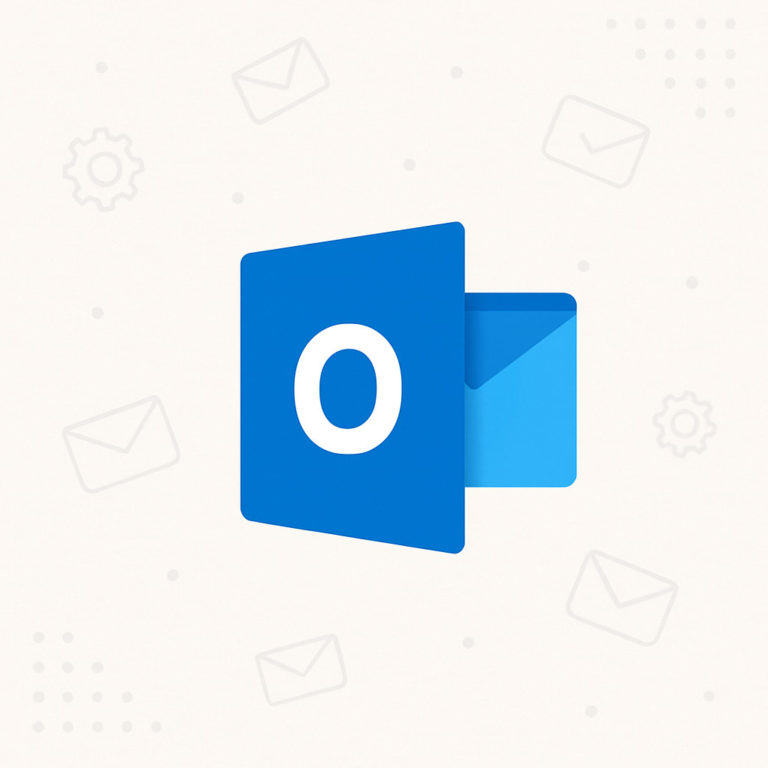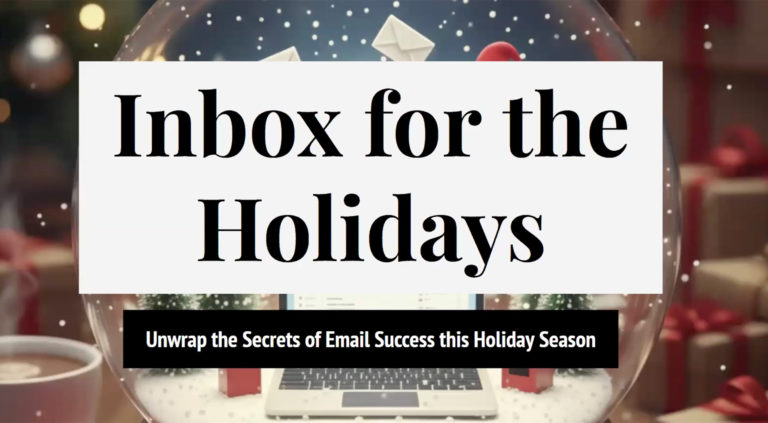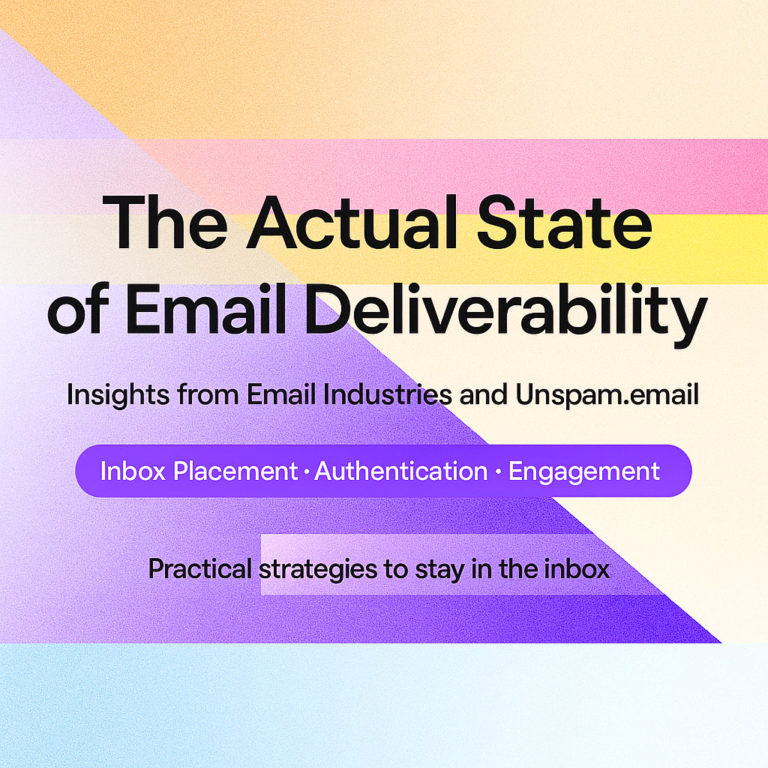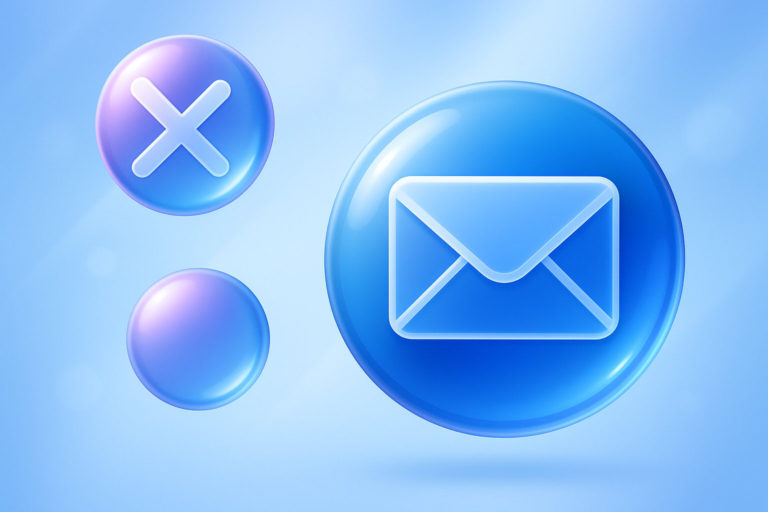Are all your perfectly crafted, hyper-personalized, and valuable emails landing in the spam folder or being rejected? This often occurs with companies that have recently begun their journey of conquering the email channel. Overly enthusiastic, they strive to make the most of every outreach by sending thousands of digital newsletters at once; however, neither ESPs nor ISPs like such pushy behavior.
As a newcomer, first, you must demonstrate to all participants in the email ecosystem that you mean no harm and intend to deliver only value to your recipients. The only way to do this is to stay low and play slow, avoiding spammer-like behavior. This means you must start with a small number of digital newsletters sent to a small number of subscribers and gradually increase your volume.
This approach is called warming up your email and domain, which is critical for establishing a solid foundation for email strategy and ensuring you can use the channel for your marketing, advertising, and branding endeavors.
Importance of Warming Up Your Email and Domain
Warming up your email and domain is a process of gradually increasing the number of messages sent from a particular address and web source to avoid intimidating ESPs and ISPs and earn a strong and healthy sender’s score and reputation.
This process typically takes months, requires human resources, and demands total commitment, yet it is worth it. Since it is the only way for companies that desire to unlock all the benefits of direct outreach through the email channel to prove their legitimacy and trustworthiness. Here are other good arguments for introducing a warming-up routine in your email marketing strategy.
Avoid Looking Spammy
The first reason why warming up your email and domain is crucial is that it is the only way to prove your validity and trustworthiness to key participants of the email ecosystem, including email providers, internet service providers, blacklist vendors, and anti-spam organizations.
The deal is that when the new or so-called “cold” email address or domain (i.e., one that has never been engaged in email communication and sent any messages previously) starts to send thousands of messages at once, it looks and behaves exactly like a spammer. ESPs and ISPs react to such malicious behavior with countermeasures, either blocking the sender or putting the email right into the spam folder.
However, starting slow and low by sending a small number of messages to a small group of highly engaged subscribers allows the digital correspondence to earn trust and pass through spam filters smoothly, reaching the inbox folder.
Build a Strong and Healthy Sender’s Score and Reputation
Many factors influence the sender’s score and reputation. These could include engagement rate, IP reputation, or domain history, but first and foremost, it is the ability to meet ESPs and ISPs’ rigorous requirements, which, when failed, are reflected in bounce rate and spam complaints.
By sending secluded email campaigns for a small group of people with a reasonable cadence, companies ensure that every outreach effort meets high email standards. This results in positive key email performance metrics that indicate the company’s relevance and trustworthiness.
Improve Deliverability
Warming up encourages companies to take a hyper-personalized approach to outreach and prioritize quality over quantity, increasing the chances of landing in the user’s inbox. This results in a positive sender’s score and reputation, a minimized bounce rate, and higher engagement, which underlies great email deliverability.
How to Warm-Up Your Email and Domain for Trust Building?
So, how can you warm up your email and domain to build trust, improve deliverability, achieve a positive sender score, and unlock the full potential of the email channel? Here are several basic steps, along with professional recommendations.
Devise a Warming-Up Strategy
Everything starts with a thorough understanding of the process and its nuances and challenges. This helps you make informed decisions, devise a strong strategy, and allocate resources without wasted investments.
Start by deciding whether to warm up your domain or just an email address. This choice largely depends on your marketing strategy and ultimate goals. If, for example, you intend a low-volume, single-purpose outreach from a single contact address, then email warming-up is sufficient.
However, suppose you plan to create a comprehensive email marketing routine and communicate with your subscribers and users through multiple emails, including transactional, behavioral, internal, or informative. In that case, it is important to warm up the entire domain.
Also, consider scenarios that might require a domain warming-up routine. A good example is when an organization uses subdomains for email campaigns or multiple teams are involved in email marketing; in such cases, it is essential to protect the primary domain. Another good example is recovery from suspension or expecting to scale outreach dramatically within the next six or twelve months.
Afterward, dive deep into your industry and email standards. You need relevant information about your sending limits and benchmarks. For example, Microsoft allows its clients to send 10,000 emails per day. In contrast, Gmail allows only 500 emails per day. However, this number can be increased four times when you upgrade to a Gmail Google Workspace account. As for benchmarks, it is essential to understand your limits regarding bounce rate, engagement rate, and spam complaint rate and not exceed them.
Finally, devise a warming-up program. Much like any email marketing strategy, it must consider vital factors such as the target audience, segmentation, hyper-personalization, timeline, and targets. For instance, you might devise a plan to send no more than 200 emails to existing subscribers per week, gradually increasing this number. It is also important to note that the warming-up strategy must have a stage for checking your digital newsletters in Unspam and analyzing email performance to make relevant adjustments and enhancements.

Notes:
- Gmail’s free‐account SMTP limit is 100 emails/day, but you can send up to 500 emails/day if you’re using the Gmail web UI; Google Workspace bumps that to 2 000 emails/day.
- Outlook.com free users can send about 300 emails/day (max 100 recipients per message). Microsoft 365 (paid) raises your quota to 10 000 recipients/day (max 500 per message, with a separate “cold” limit of 1 000/day for new contacts).
- Zoho Mail’s free tier allows 50 emails/day per user (up to three users = 150 emails/org). Paid users get 300 emails/day each, with mass-mail limits of 250–2 000/day based on your edition.
- Yahoo Mail free and Plus users are both capped at 500 emails/day, with a 100-recipient/message cap.
- iCloud Mail has a 1 000 emails/day limit.
- ProtonMail’s free tier is 150 emails/day; paid plans go up to 1 000+/day depending on the plan.
- Yandex.Mail and AOL Mail each allow about 500 emails/day, with per-message recipient caps of 100.
Authenticate Your Messages
The second critical step is technical preparation. Whether you send one or a million digital newsletters, they must be authenticated. Authentication is critical for companies for many good reasons. But, first and foremost, it allows them to reach Gmail and Outlook users, as since 2024, these two industry giants have been accepting only fully authenticated messages.
In addition, introducing safety protocols in your communication is the best way to prove to ESPs and ISPs your legitimacy, reliability, trustworthiness, and honest intentions in the communication channel. It protects you and your domain by preventing hackers from spoofing your account. Therefore, even if you do not target Gmail or Outlook users, you still benefit greatly from authenticating your emails.
The authentication routine consists of two basic stages: setup and testing.
The setting-up stage implies that companies introduce safety protocols in their digital newsletters and technical environments. This means configuring SPF, DKIM, and DMARC and adding the corresponding records to the server. Briefly,
- SPF is a Sender Policy Framework that specifies domains authorized to send emails from your company’s name.
- DKIM is a Domain Keys Identified Mail that uses encryption to protect outgoing emails from being tampered with or compromised.
- DMARC is a Domain-based Message Authentication, Reporting, and Conformance protocol that combines SPF and DKIM into a single system, enhancing protective capabilities.
The testing stage involves inspecting emails to locate inconsistencies or faux pas in authentication to ensure everything works correctly, protects your email from being spoofed, and delivers crucial technical information for ESPs and ISPs so that they can check the legitimacy and trustworthiness of the connection.
Start Slow and Low
Sending a small number of digital newsletters to a specific group of subscribers, no more than once a week is the best way to start your warming-up routine. While the volume choice largely relies on your technical environment limits and industry benchmarks, experts advise starting with no more than 300-500 emails in one outreach and gradually growing this number.
As a rule, companies can boost their volume when they get a positive reaction from ESPs, ISPs, and recipients, such as a steady rise in deliverability rate, key performance metrics, and sender score. However, you still need to do it gradually. Do not triple the number of messages overnight because of the previous success – take a steady approach.
For that, follow these professional recommendations:
Segment your subscription list. Prioritise recipients who are actively engaged with your brand and product. As user engagement directly influences the sender’s score and ESP’s attitude towards your messages, it must be taken seriously.
Create hyper-personalized content. The good news is that with a small volume, creating content that resonates with your subscribers will not take much time, effort, or resources. Analyze their preferences and address their pain points with your message.
Define the right time. Time is critical for every email campaign. Ensure you understand your target audience’s behavior patterns and preferences so that you can send them digital newsletters when they are most receptive.
Maintain Regular Conversation
Warming up email and domains is a process that aims to demonstrate your trustworthiness to ISPs and prove your credibility and value to recipients. The best way to do this is to create hyper-personalized dialogues and maintain them regularly. Establish conversation threads and encourage your recipients to send you contextual replies, ensuring a meaningful dialogue and gradual engagement with the brand. This will strongly signal ESPs and ISPs that your communication is valuable and trustworthy.
Even if your email marketing strategy does not aim to elicit responses from your recipients, you may still benefit greatly from promoting regularity in outreach. First, your users will know when to expect you in their inboxes. Second, ESPs and ISPs will not be intimidated or confused by your chaotic sending behavior. Third, you might devise a strong email marketing routine. Finally, you may boost engagement and maintain a healthy subscription list.
Therefore, think through the frequency and regularity of your outreach. Inspect your industry and the target audience’s preferences and expectations for real insights. Conduct A/B tests and analyze the best-performing messages to define the most appropriate frequency and cadence.
Check Email in Unspam
The next step in the warming-up routine is inspecting and checking every email in Unspam. Right before hitting the send button, you must be sure that every detail works as intended. From a technical side to the content of your digital newsletter, everything should meet standards and demonstrate your positive intentions to bring value to subscribers while contributing to a safe email ecosystem.
Many factors are involved, but first and foremost, you must check the following:
- Authentication.
- Safety of the domain, server, and environment.
- Descriptive and transparent brand name, email address, and domain.
- Non-pushy and non-spammy subject line and content that delivers value.
- Compliance with laws and regulations.
The best way to ensure these aspects are in order is to test your email in Unspam. Unspam is a professional email spam checker and deliverability test platform. It is a comprehensive instrument that has proven valid to thousands of clients worldwide. It thoroughly inspects your digital newsletter, surfacing the tiniest inconsistencies and errors that might trigger spam filters or decrease your engagement with subscribers.
Even though Unspam is a highly advanced instrument, it remains easy to handle and interpret results. It was built with non-tech-savvy clients in mind, providing them with an intuitive interface and a well-structured, organized report. In addition, it offers professional help from email marketing experts, who will help you improve your deliverability and ensure a smooth and flawless warming-up routine.
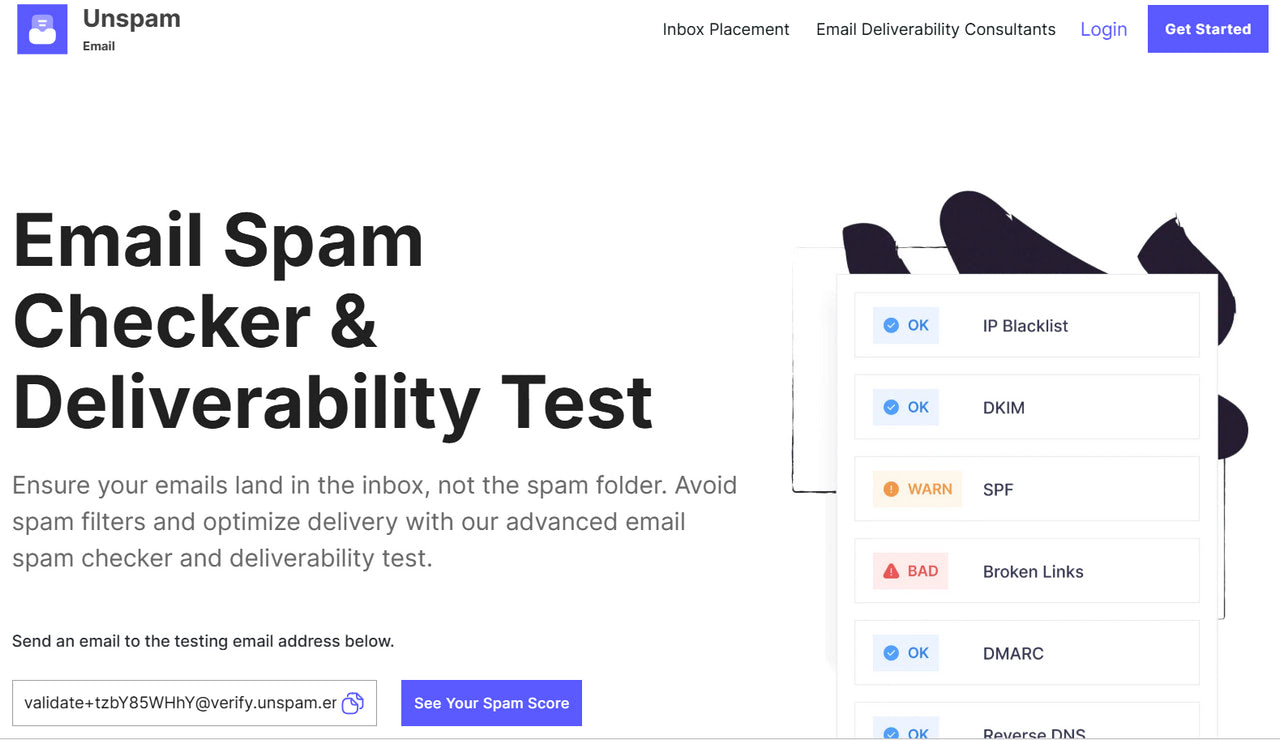
Monitor and Analyze Key Email Performance Metrics
Monitoring and analyzing key email performance metrics is the last stage in the warming-up routine. Like in email marketing, this is crucial to ensure successful endeavors. Providing real insights on how well or poorly your decisions were gives you a direction for improvement and enhancement, along with surfacing opportunities to engage the audience even more.
Even though warming up involves a small number of subscribers, you might still collect important information for future email campaigns like promos or sale events by understanding their expectations and preferred content and cadence.
So, open Google Analytics or your preferred tracking tool and monitor and analyze key performance metrics. At a minimum, focus on bounce rate, spam complaint rate, delivery rate, open rate, conversions, engagement, and sender’s score and reputation. It would also help to track domain health.
Professional Recommendations for Warming-Up Email and Domain
Here are some of the professionals’ best recommendations for amplifying your efforts during warming-up emails and domains.
Use a specialized tool. Automate the routine to save time, effort, and resources for building campaigns, tracking key performance metrics, and adjusting the warming-up correspondingly.
Take your time. Warming up may take time. According to statistics, earning trust with ESPs and ISPs and preparing your email and domain for bigger outreach might take two to six months. So, no rush – stick to your plan and gradually grow.
Follow the best practices in email content and design. User engagement is essential in forming your sender’s score, directly affecting your ability to bypass spam filters and land in your inbox. Therefore, ensure you have perfected your digital newsletter’s copy and visual aspects to secure a positive response.
Clean the subscription list regularly. Never purchase contacts. The quality of your subscribers determines the success of outreach and serves as an indicator of your trustworthiness.
Conclusion
Warming up your email and domain is critical for all newcomers to the email channel. It helps them prove their legitimacy and trustworthiness to ESPs and ISPs and establish strong, healthy, and non-pushy relationships with subscribers. Slowly but surely, it introduces the company into the ecosystem, turning it into an integral player in the arena.
This process implies several important stages. However, at its core, companies must maintain a gradual routine of reaching their subscribers. Depending on the industry benchmarks and limits, they usually start with just 500 emails per day and increase this value when they see a positive reaction. It might take time, but it is worth it as it is the only way to ensure the key participants of the email environment consider it a trustworthy entity and let it conduct its email campaigns uninterrupted.


